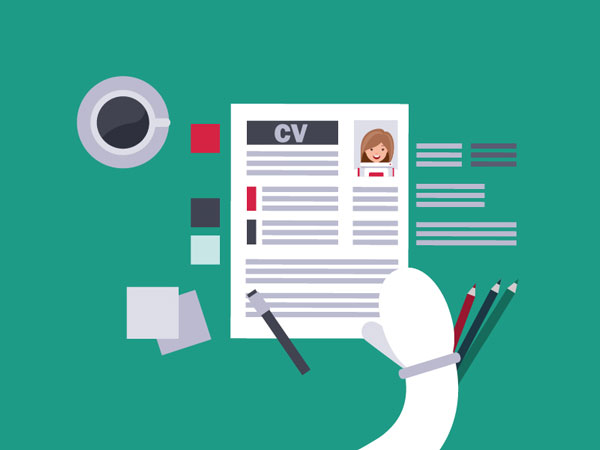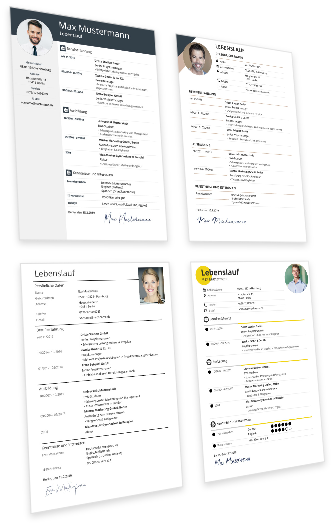
Your job application needs to be compelling at first glance. That's why your resume should make a good visual impression while allowing the details of your life to speak for themselves. But don't worry: just follow these guidelines and you can compile your personal information into a concise and appealing resume.
Resume Layout—the Basic Structure
The first thing you should do when writing your resume is to figure out which information about yourself is relevant to your job application. You may want to start by collecting every bit of information about your educational and work history so you can get a good idea about the scope of your resume. You'll also be able to see which stages of your life require additional information and which stages you could keep more concise to save space. Your personal (contact) information should never be cut from your resume of course, as it serves as the foundation of your job application.
Make sure that your recruiter can identify the most important pieces of information at a glance, by following this overall structure:
- Your personal details
- A short resume profile
- Your work experience
- Your educational background
- Knowledge and skills
- Optional: Hobbies
The most useful layout for your resume is a two-column layout with dates and time frames on the left and details on the right. This allows recruiters to see all the stages of your career or education at a glance, while leaving plenty of room for adding details about what exactly you did at your previous place of employment. So, the layout should have the date on the left side, followed by the corresponding job title or a short description to the right, such as "training as a bank administrator" or "retail salesperson". You can also put additional information underneath that title or description, such as your final grades, projects you worked on, or the responsibilities your job entailed.
You can highlight important details, but be sure not to overdo it, as this may make your resume harder to read.
Use Resume Templates for a Straightforward Layout
If you lack confidence in your ability to create your own layout, you can always use pre-made resume templates. They're easy to fill in, which saves you a lot of work and ensures your resume will look professional, even if your layouting experience is limited. Good templates have a cohesive appearance that fits well with your job application portfolio.

Simply fill out online, download and apply!
Start now!Your Resume Layout Should Follow a Common Thread
In terms of visual design, your resume layout should follow a common thread, just as the content of your resume does. To create a consistent design that follows a common thread, you should consider the following elements:
- Use a consistent font: Use the same font in all of your documents and a consistent font size between 10 and 12 pt.
- Color usage: Colors can help to highlight key information, enhancing the visual structure of your resume. But make sure your resume doesn't become too colorful. Limit yourself to two accent colors at most. If you want your resume to show that you've done your research, consider incorporating the primary colors of the company where you're applying for a job.
- Use graphical elements: Bullet points or lines can be used to structure your resume if you're using them consistently. Always leave the same margins and coordinate the positions of the lines to create a consistent appearance.
- Spacing and positioning: Ensure that margins, line spacing and the positions of the individual sections of your resume follow consistent rules.
Are There Any Hard Rules for Your Resume Layout?
While most recruiters will accept a resume that was made following the guidelines above, there are no official rules for structuring your resume in the US. In fact, some job seekers with little to no work experience may choose to list the skills they've acquired instead of following their employment timeline. However, be mindful that certain countries may have recognized official norms. Though they may still consider your application if it doesn't comply with these norms, not following them may not always work in your favor.
For job applications in the US, you can simply follow the rules outlined here. But when applying for a job abroad, you should always check whether there are any official rules or widely-accepted norms you're expected to follow.
Make Sure Your Resume Is Easy to Read
Since there are no official norms to follow for resumes in the US, it might seem as though you have a lot of freedom to choose a layout that suits you and the position for which you're applying. But always keep in mind: The structure of your resume is supposed to help recruiters find the information they're looking for. If your resume is structured in a highly unusual manner, they may not find crucial information quickly and may decide that your application is not worth their time. In short, clarity and readability are paramount factors in your resume layout.
You may still be able to attract a recruiter's attention with an unconventional resume structure, of course. However, your structure should follow a few general guidelines to ensure readability:
- Leave enough space: You generally don't have a lot of space in your resume to convey a great deal of information, so your resume should never be longer than two pages. If you try to fit every bit of information into these two pages, you can easily end up with a resume that's hard to read because there's just too much text crammed together. Prioritize information that is relevant for the job at hand to ensure that the most important pieces of information stand out.
- Adjusting text alignment: In business letters, the text is usually aligned flush to the left, but you're free to change this for your resume. For example, you may want to align the dates on the right, putting the corresponding work experience information on the left.
- Appropriate font sizes: Using two different font sizes in your resume is usually enough to provide some visual structure to the text. Using more than two different font sizes can quickly make your resume look chaotic. Use the largest size fonts for headers. If you're trying to emphasize certain words, use bold font to make them look bigger without using a larger font.
Some Additional Guidelines for a Professional-Looking Resume
You don't need a graphics design degree to create your own resume layout and design. Just follow these tips to make your job application stand out:
- Try out different layouts: Once you've collected all relevant information, you can try out what they look like in different layouts. This will help you determine which layout and structure work best for your job application. You may also try out pre-designed resume templates, which are easier and faster than creating your own layout.
- Print and compare: Even experienced job seekers print out their documents to compare different versions. This may even help you spot small mistakes and inconsistencies, like different font sizes where you don't want them.
- Proofread: Never forget to proofread your job application before you submit it. Find one or two other people to proofread it for you, as they might find mistakes you've missed. Once again, print out your resume so your proofreading friends can mark mistakes and comment directly on the page.
